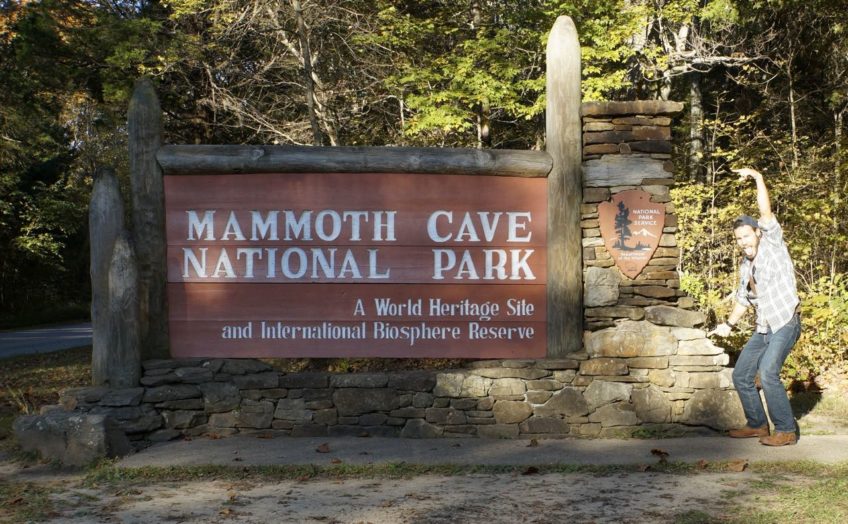Departing the Blue Ridge Parkway was somewhat bittersweet and for more than one reason. For starters, it meant moving on from one of the most beautiful sections of my trip thus far. I intend to figure out what exactly about the flora, atmospheric conditions, or general magic of the Smokys creates the “Blue Ridge” effect. Other than the beauty, leaving the Blue Ridge also means venturing into a part of the country that I have not yet explored very extensively, if at all. So far in my trip, I have been driving through parts of America that I am either fairly acquainted with or know intimately. Kentucky, Tennessee, Alabama, Mississippi, Arkansas, and Texas are relatively foreign to me, a feeling that is both exciting and a little nerve racking, but that is what this trip is about!
After spending a day working in Boone, I headed northwest on Virginia’s Crooked Trail (a wildly curvy and beautiful road dedicated to famous folk musicians from Virginia) for the Cumberland Gap. Even though I got there after the visitor center closed, I hiked up the Pinnacle Overlook trail just before the sun started its descent towards the horizon. From the overlook, it was obvious why hundreds of thousands of westward expansionists had headed for the Cumberland Gap. One of three passable sections of the Appalachian Mountains, it stands as a monument to the idea of Manifest Destiny that gripped Americans in the early nineteenth century. Having driven through the tunnel underneath the Gap, I didn’t get the same experience. Nonetheless, staring out at the plains on either side of the mountains justified the settler’s decision. Leaning against the rail, I started realizing that the sunset from this vantage point might not actually be that spectacular. An absence of patchy clouds and a non-descript, high horizon line might hide some of the most spectacular colors. Returning to my car and driving back down, I soon realized that I had discovered the best place to watch the sunset. The golden light was pouring through the canopy of red, orange, and yellow leaves, creating a blaze of color over the wonderfully curvy road descending the gap. With everyone else waiting up at the overlook, I felt safe stopping in the middle of the road and enjoying the sunset right there.


Continuing late into the night, I positioned myself for an early assault on Mammoth Cave National Park. One of four cave systems in the National Park system, Mammoth Cave is the longest cave anywhere in the world, even though they didn’t know that when it was originally established. In 1941, spelunkers had mapped just 44 miles of cave running through this layer of limestone in central Kentucky. Now, the mapped tunnels and caverns of Mammoth stretch for 405 miles and there is no end in sight. Every year, groups of surveyors map more and more of the cave. Experts believe that it could stretch for more than a thousand miles. To me, this demonstrates a whole other level of “wild” for the National Park System. Places like Glacier and Yellowstone may continue to amaze millions each year with their awe-inspiring vistas and natural features, but Mammoth contains the unknown. In this age of information that we so comfortably inhabit, that is true rarity. When Google Maps can bring a Street View experience of the Grand Canyon to anyone with a computer and an Internet connection, Mammoth still holds countless miles of mystery and virgin cave. Just imagine the possibilities…

When I showed up at Mammoth, I wasn’t entirely sure what I was going to do. I knew I had to do a cave tour, but I also wanted to explore the surface. The layer of sandstone and shale that caps Mammoth Cave is what has preserved it so well. Limestone, a water-soluble sedimentary, is a master cave maker. If you’ve got a limestone formation with any flowing water, chances are you’ll have a cave after millions of years. What makes Mammoth unique, and such a stable cave system, is that it has a roof of sandstone and shale that protect the limestone underneath from surface water eroding the many roofs of the caverns below. I wanted to see both.

After checking in with a few rangers, I decided on the Grand Avenue tour, a four-hour, four-mile jaunt that started in the historic section of the cave, ending at a section discovered early in the 20th century containing many of Mammoth’s most spectacular formations (at least the ones that are accessible to the public). In the height of the summer season, the Grand Avenue tour caps out at over one hundred, mine had just over thirty people on it. This meant that our guides, Eric and Rose, could take their time and really delve deeply into the history of the caverns that we passed through. I hung out near the back, with Rose, peppering her with questions. In return, she let me lag behind to take all the photos I wanted and showed me a few echo tricks and tunnels running off of the main passage. Eric, our lead guide, was a self-described “Kentucky Boy” through and through. His accent, mannerisms, bad jokes, and inescapable knowledge of the cave were incredibly informing and highly entertaining. They were a great pair.

With depths ranging down to 280 feet, our group wandered the caverns, tunnels, slots, and canyons of Mammoth cave. In the historic section, we saw remnants of previous visitors dating back thousands of years. The majority of the historical record of those 19th and 20th century tourists can be seen in the walls of the cave. Participants could pay guides to inscribe their names, state of origin, date of visit, army regiment, etc. on the walls of the cave. Since 1941, this practice has been vehemently discouraged, but the historical graffiti from that different age still reminds us of that not-so-distant type of tourism. As a result, the walls of Mammoth bear testament to the Civil War soldiers, east coast elite, and adventurers who wandered the darkness of Mammoth in its early days. Once you realize that they did so in their best clothing with minimal lighting, you begin to understand how different their experience might have been than your own.

In terms of geology, the only rock you see in Mammoth Cave is limestone. In some areas, that limestone is adorned with graying gypsum that almost looks like sparkly bread mold. Once snowy white and far more crystalline, the black smoke of lanterns of nineteenth century tours quickly dulled the purity of the gypsum in the historic section. In other sections, cave crickets scurry along stalactites and stalagmites as tall as I am. These impressive, but slow-growing features were once a prized souvenir from Mammoth. They are so fragile though, that even touching them can kill them or severely stunt their growth. Water burrowing downwards has left behind massive “waterfalls” of braided limestone; one in particular earned the name “Frozen Niagara”. Deep beneath our tour, that water still winds through deep river passages of Mammoth, delving deeper and deeper into the limestone.


The beauty of Mammoth is shadowy and damp, but it is stunning nonetheless. The caverns are massive, allowing room for dozens of people to walk unencumbered without feeling any sense of claustrophobia. The improvements the Park has made, from a small kitchen in Snowball Cave to restrooms in two different sections feel out of place, but don’t intrude greatly into your sense of wonder. The most amazing moment, however, occurred when we turned all the lights out. I opened my eyes and saw nothing. Absolutely nothing. Total darkness enveloped me. As our group sat in silence, we began to hear the gentle drips and murmurings of the cave. The darkness and silence felt incredibly heavy, pressing in on all sides. Now close your eyes and imagine 405 miles of darkness, fanning out underneath central Kentucky… Now, you have some idea of Mammoth.

My Above-Ground Travels!




5 Responses
Eric Elder
Thank You from the Ole Kentucky Boy……Ranger Eric
jcronon
You were great Eric! Thank you for introducing me to the wonders of Mammoth Cave!
Phil Brode
It was a pleasure hiking the Grand Avenue at Mammoth Cave N.P. with you. I thoroughly enjoyed our discussions while taking in the wonders of the cave. All the best on your grand adventure. I’ll be following your travels, with envy.
jcronon
The pleasure was all mine Phil! It was great to pick the brain of someone who is so familiar with the Parks. Hopefully, the next few years will bring you a few adventures that close out your own list of remaining parks. Safe travels and happy trails!
Mary Kelly
Awesome!
Mary